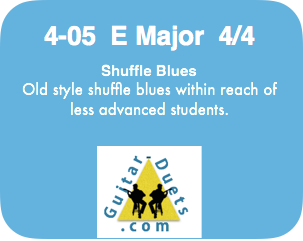
Basic Idea
As guitar teachers we know that reading music on our instrument is a challenge, which is probably the reason that tab is everywhere these days. Being able to read traditional notation is a big advantage however and – after the initial learning curve – means a big forward step in achieving proficient musicianship. Standard notation can be read by any serious amateur or professional, whereas tab is only shared among fellow guitar aficionados. A student who can read will also have access to a vast body of guitar literature. It’s the main reason these duets don’t come with tab.
Duets are a great device for teaching:
- it’s music, not dry scales, chords and theory (although these matter as well of course).
- they promote social competence: aside from playing the duets with the teacher, another student can be drawn in, so you combine the face-to-face with (a short) ‘duo’- lesson, as students come into and leave the lesson.
- the playbacks enforce strict timing and so you can teach your student to acquire a good sense of rhythm. This can be unwittingly neglected, when playing without bass and drums.
- a well developed sense of rhythm prepares students for ensemble playing.
Consistently working through one of these in the first five to ten minutes in most lessons will have your students read music sooner rather than later. The duets are mostly kept short and thus won’t take up much lesson time and won’t be considered a difficult task. A suite of various playbacks are provided with every duet. All guitar parts have been recorded by the author (no midi!), whereas bass and drums have been created electronically. A wide variety of keys, meters and styles characterise these pieces (for details see above).
Last but not least as teachers we have to offer our students pieces they like to play (and we like to teach!). You will find at least a dozen duets among the provided 70 which will please every student’s ears. They will be eager to play their chosen ones.


